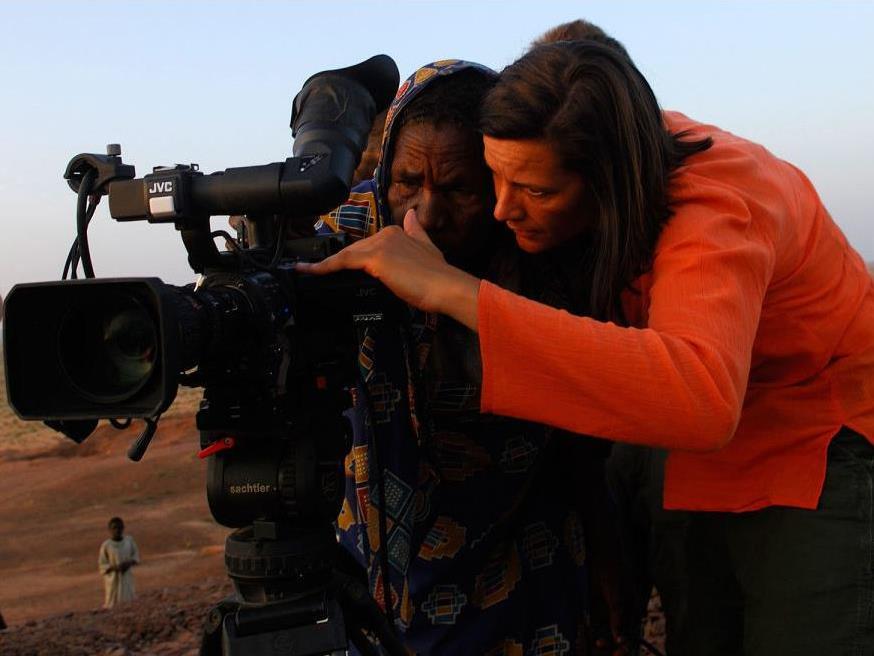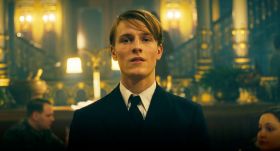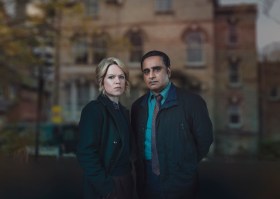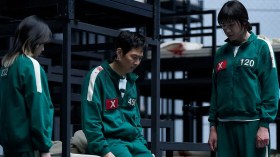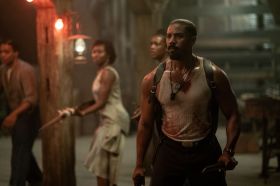Image: Kirsten Johnson in her film Cameraperson, credited to Lynsey Addario / Janus Films.
For over twenty years, Kirsten Johnson has travelled the world as a documentary cinematographer, capturing horror, sitting in on shattered families, standing back as unknown figures go about their lives. She has been to Bosnia, Uganda, Rwanda, Yemen, Liberia and Myanmar. She filmed Citizen 4, worked on Fahrenheit 9/11, and contributed to Frontline/World and Independent Lens.
At home in the US, she documented her family, freelanced on local productions, taught and gave birth to twins.
What does she see when she closes her eyes at night?
Her film, Cameraperson, is an extraordinary reflection on the images that stayed with her, based entirely on field tapes which she uses as a meditation on memory and responsibility.
Cameraperson Trailer from Janus Films on Vimeo.
The first scene sets you off. A man on a horse herds sheep up a road. The unknown cinematographer holds the shot until the camera abruptly moves to other angles. We see the close ups, the establishing shots and the wide as the farmer comes towards us behind the animals. The sound is entirely naturalistic, but we also hear the audio which is always excluded, even in films that use the fragmentary moments at the ends of shots. We hear someone panting from exertion.
Kirsten Johnson is a woman at work, using her mind and eye to intercede with reality, breaking it into shots and editing assets, carrying real life into the magic, imaginary world of images to be rebuilt as some tunnel into the essence of that moment.
She studied at Brown University in the US, worked on films in West Africa and then went to FEMIS, the French National Film School to study cinematography. She graduated in 1994 and has been filming ever since.
She is thoughtful and articulate. As she does with the film, you can feel her weigh reality and form it in the way she wants, answering and not answering questions and riffing in her own directions.
I wondered how she went about organising the material. There must surely have been an underlying principle?
‘In some ways that wasn’t really the process.’ she said. ‘It wasn’t initially about trying to tell the narrative of my life or any chronology of the work I have done.
‘I was trying to understand memory, and why certain things haunted me. The order in which I went looking for footage was dependent on how much it stuck with me and also the question for me was what was in the material that I had shot as compared to what I have remembered about it.
‘So it was much more about me trying to figure things out for myself rather than to do a whole spectrum of what I have been through. it was more about me trying to engage with specific questions, if that makes sense.’
You were interested in the extraordinary stuff about the act of looking?
‘Yes.’ She spoke very definitely.
And the fact that the only evidence you have is the evidence which is in the frame?
‘Right.’
The difference between the reality which you experienced and what actually turned out to be in the image came through for me very powerfully.
‘In some way I was looking for a way to make a note to all that can’t be in the images. When you frame the world you are leaving out, and the sensation I experience a lot as a cameraperson is the terrible feeling that I have missed everything even as I am attempting to capture as attentively as I can a situation that I don’t really understand.
‘It’s like a struggle in many ways against my own internal feelings of inadequacy or naivete – all the things I don’t understand as I try to gather any evidence I can. I get the impression I’m getting something by the skin of my teeth and only occasionally do I feel “Oh, I’ve got it.”’
‘Sometimes by a miracle I’ve got it, sometimes when I think I’ve got the thing of importance, it will never be in the movie. Other times in my searching I come across something that really was unique but I didn’t realise it at the time.’
In one of the most remarkable scenes in the film, we see a woman give birth in a Ugandan hospital. As she is nursing the baby, we realise she is having twins. The second child is damaged, but the place is very basic. Is the baby okay? She needs oxygen says the physician, but we have no oxygen. The poverty of the hospital cuts to our hearts, but the scene doesn’t come to a conclusion. Johnson was just hanging in with her camera.
‘I didn’t understand about the medicine or the need for oxygen and I kept filming because I hoped for a happy ending.’
It was very starkly clear in the film that the lack of oxygen was a problem.
‘Yes. But many audiences see it and don’t understand that and it’s a metaphor for so much of the film. We each look at things differently with different experiences and we are able to understand the dimensions of it differently.’
Later in the film we discover that Kirsten Johnson is also the mother of twins. Her own life reaches across the lens to engage her in the reality framed by the camera.
Those experiences rhyme with your own life and this is also strongly stressed?
‘Yes absolutely.
‘I filmed that scene before I had twins and it was deeply significant to me. But there is no question that it compounded once I had twins. There is a powerful back and forth between what happens in one’s own life and other people’s lives, and I am always questioning and wondering why it went this way for you and that way for another person. How breaks keep falling our way as we watch the breaks fall the other way for other people – and how do you navigate being in that space?
‘There is no question for me that the doubling of the twins and the mere nature of twins became a thing for us in the cutting room. The mirror that is the footage, the mirror that is the person across from you and that idea of reflection – things that I really get into on an intellectual level actually are present in the footage which we found so thrilling and was part of our criteria by which we chose the footage.’
The editing process on Cameraperson was extraordinary. It started out to be a completely different film, called A Blind Eye, shot with two teenagers in Afghanistan and edited over three years with Amanda Laws as editor.
‘When we were almost finished the film I showed it to one of the young women and she said, “I am really sorry but I have to take back my permission to be in the film. I am now too afraid to be in the film”.
’It was just a horrifying moment because we had built the whole film around her presence and yet I felt very much compelled to honour her wishes. I didn’t live in Afghanistan, I wouldn’t have to live with the consequences of the footage and she would.’
She did allow her voice to be used, and shots which did not show her face. On that basis, they kept cutting over another year. They tried using voice over, but her absence destroyed the film.
‘It really made me think about the relationships I have with people when I film and the way things change over time. In 2009 it felt safe and fine to have her in the movie but by 2012 that was a longer true and that made me think about other things I have filmed and how time has changed my relationship to them. And that’s what made me want to go back into the footage.’
Trying to solve what she calls ‘the riddle of the broken film’ she began to watch footage which she had shot on other projects, and brought in the Nigerian maternity ward sequences. It took them completely sideways.
‘We strung together a whole new cut using footage from all over the world and it was really painful and awful.
‘That was a huge revelation. Of my state. I wouldn’t have said that I have post traumatic stress but I clearly need this terribly traumatic film in a way to show myself how much I had taken in and the way that I thought it was manageable but it was not. It was about a two and a half hour cut and it was a litany of horror really. So much so the producer working with us had to close her eyes while watching most of the entire movie.
‘And that’s when I realised I needed to take a break.’
‘We realised that Amanda was done, and I started searching through stuff and working out what was I trying to do with this film and whether I was just trying to re-traumatise myself or beating myself up for my impotence in the world.
‘Because you do feel terribly impotent – you can go out of the situation where people are suffering in terrible ways and you don’t know if your film work is shifting that or exploiting that or misunderstanding it. And some times you know you are giving some comfort to people and then you even question yourself and say, “Was that a false comfort?” I know in the moment when I was filming I hoped something that come out of the filming but did anything come out of the filming?
She calls the production a quest, in which she ultimately found the right editor for this new project, Nels Bangerter.
‘And we come upon the idea that we would do it without voice over and that was just the idea. That was the key idea of this film because it allows the footage to speak for itself in a couple of ways and just expanded the possibilities of what the film could be and all of the ideas I hoped could be in the film actually found a space without the voice-over.’
She was working with scenes which had been shot for other films, with separate directors, which she did not ultimately own. So she had to gain their consent to use any of the footage. But she wanted to take this further, to go back to all the people in the footage. In practice, the idea was hopelessly idealistic.
‘Basically at a certain point the producer said, “We can’t afford for you to work for two years on this and then go to a Nigerian family and have them say no sorry you can’t use that footage in your film.” I accept that and own that as part of the complexity of film work.’
They were living in the shadow of the previous refusal, but the films are really very different. The other films are finished, and have been screened so the consequences of the publicity have already emerged. Consent with these participants is much less meaningful. Besides, images in public are now beyond consent.
‘Everything turns up on the internet and we can’t necessarily control what happens to our images once they are filmed and that’s part of the moral conundrum of being the camera person. But it is my dream that eventually everyone in the film will see the film and see themselves in it and I will be able to speak to them about the complexity of it.’
Still, this is very slippery territory, and the film deliberately raises the ethical issues of the craft, mostly by implication. She acknowledges the mess.
‘In many ways it is impossible to be completely ethical and and the question of permissions or ownership of images is connected to power and privilege.’
The question of consent to filming comes to the fore in sequences from her own film about her family, which focus on her mother who has Alzheimer’s. I am fascinated by the tenderness in these scenes, because we know the daughter is filming the mother and the relationship with the camera is a connection across a lifetime. The act seems completely different, makes the connections in those crisis films seem emptier and more mechanical.
While I wanted to talk about intimacy, Johnson was still musing on consent.
‘I always think about why someone is letting me film them but certainly in the case of my mother, she wasn’t. When I filmed her I was sort of sneaking the footage from her because I knew she didn’t want to be filmed. For me that puts it back onto the why I was filming. Why does it matter to me that I don’t want to film against the will of someone who is beyond the capacity to give permission? Like with the children.’
Ultimately she uses an argument which is shared with frontline photographers. There is a kind of implied consent beyond the discomfort of the moment. In her family scenes, people do retain the capacity to actively resist by arguing or walking away.
We tumbled into this question in a half hour interview and it needed much more discussion. But she was in New York and I was in Melbourne, and she needed to pick up her children. I had already asked the question I really wanted answered.
Did the second twin die?
Yes.
Kirsten Johnson has a complex life and she teaches in New York. There is a bunch of nice masterclass clips on Vimeo, while her own site carries substantial articles and interviews.
The film had a season at ACMI, where she gave a Q&A in February. It screened at MIFF and the Antenna Documentary Film Festival last year.
It is now available for streaming on Madman’s new documentary site, DocPlay, along with Particle Fever and Herzog’s Lo and Behold. $6.95/month.
